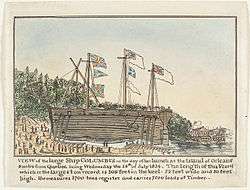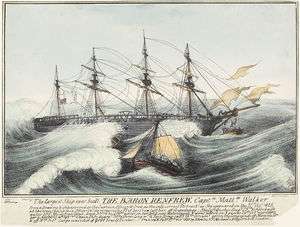Disposable ship
A disposable ship, also called raft ship, timber ship, or timber drogher[1] was a barely seaworthy vessel assembled from large timbers lashed or pegged together for the purpose of making just a single voyage from North America to England, where the vessel was subsequently dismantled and its timbers sold piecemeal to British shipbuilders. The disposable ship avoided two problems that adversely impacted profitability of shipping in the British timber trade: high taxes and small cargoes.


The structural timbers of a disposable ship were exempt from high British taxes imposed on "oak and square pine timber" cargoes. In the 19th century, these taxes eventually reached 275% of the value of the timber cargo. Further, the return voyage from England to North America was unnecessary. Typically, return trip cargo volume was one-tenth that of the timbers brought to England. This usually required the use of ballast stones to establish the proper vessel trim and maneuverability. Ballast stones had no significant commercial value and ballast loading and unloading was costly and time-consuming.
One of the largest wooden sailing vessels ever built was a disposable ship called the Baron of Renfrew. Launched in June 1825, the 5294-ton crudely built Baron of Renfrew was wrecked as it was being towed toward London in a storm. Although reports differ, most indicate that the vessel's timbers were recovered and sold, and that the venture was ultimately successful.
When the British tax on timber cargoes was changed, the economic advantage was diminished and disposable ship construction ceased shortly afterwards.
References
- Wallace, Fredrick William: Wooden Ships and Iron Men. White Lion, London, 1973/1924.
- Williams, David M.: Bulk Carriers and Timber Imports: The British North American Trade and the Shipping Boom of 1824-5. The Mariner's Mirror Vol. 54, London, 1968. pp. 373–382
- Wood, Charles: Ballast. John Clark, Glasgow, 1836.